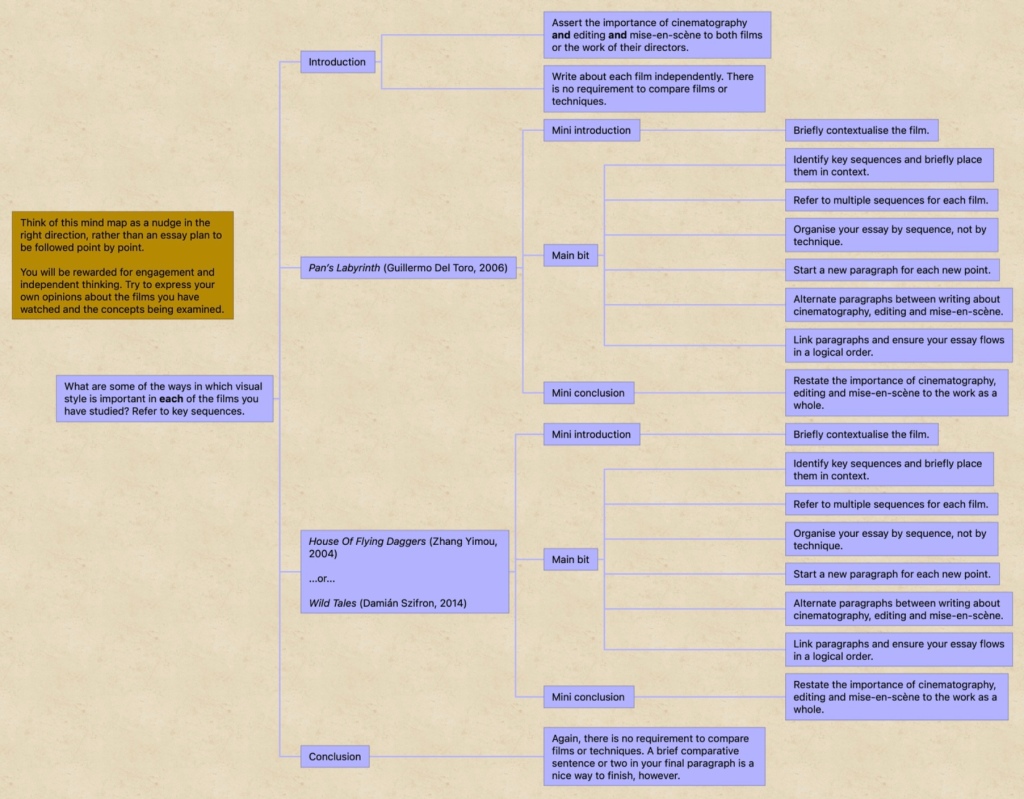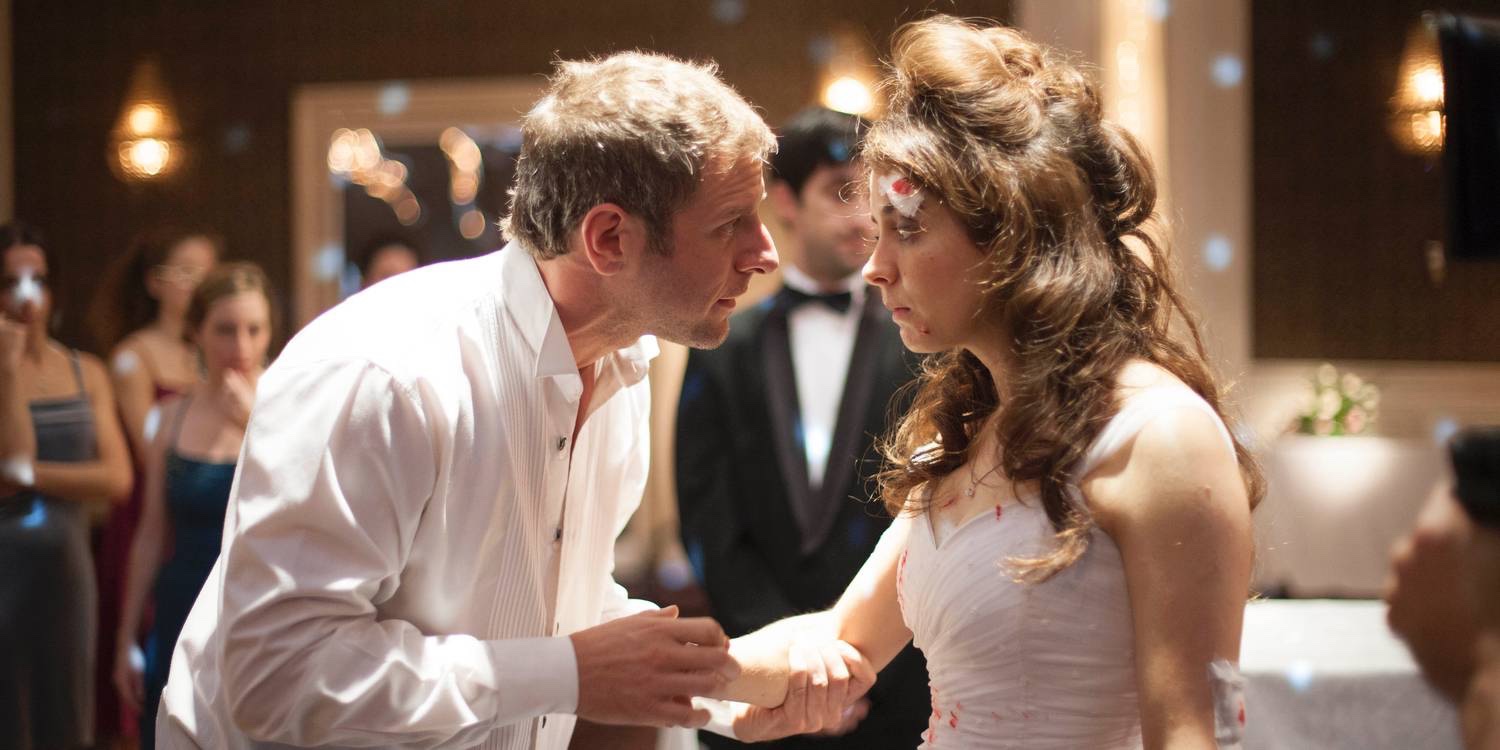“Discuss how aesthetics are used to communicate themes in Wild Tales. Make detailed reference to particular sequences in your answer”.

Essay Plan:
Introduction – Each story has its own aesthetic. Mention this then talk about how each one communicates the theme intended in each story.
Middle – Talk about wedding sequence. Talk extensively about the techniques used, how they communicate themes, what said themes are. After two paragraphs move onto diner sequence, and talk about how aesthetic differs from previous one, and repeat process.
Conclusion- Explain how both sequences use their individual aesthetics communicate their individual themes.
Version 1:
Each individual story in wild tales has its own specific aesthetics that are used to communicate the themes of each story, which differ form the others. Cinematography, mise-en-scen, performance and sound all combine to create the aesthetic, and through these the themes of each story can be inferred.
The wedding story has a clear aesthetic that sets it apart from the other story’s. The sequence begins with an extremely large and filled wedding party, adorned with expensive furniture and decorations. The mise-en-scen here gives the scene a clear opulent aesthetic, communicating the story’s theme of wealth. When the newly-weds enter the scene, the camera pushes in on them and keeps them centre frame to symbolise that they are the centre of attention and events, as is also shown through the lavish red carpet they walk in on, and the crescendo in the diegetic compiled score. When they reach their family and friends, the couple immediately separate and talk to their individual groups. We see, through performance, the couple seem extremely happy, and they have almost plastic seeming smiles on and act in stereotypical ways, perhaps as they would be expected to act at a wedding. The bride screams in joy as she runs up to her friends, and the groom shakes hands and laughs with his friends. The characters act as if their movements and expressions are completely scripted, which gives the scene an aesthetic where the characters do not act as themselves. The couples obvious separation is also shown from the shot-reverse shots between the bride and groom, whose backs are facing each other. This communicates the theme of superficiality in the story, but more specifically the couple’s fake affection for each other, which is apparent in how they never speak to each other with actual respect or adoration throughout the entire scene.
The entire ballroom is filled with flashing lights and bright and dark costumes. The contrast in the mise-en-scen and cinematography is extremely sharp, symbolising the differences between how the men and women act in this story, communicating the theme of gender inequality. This is also shown through how Romina, the bride, is kept at eye level throughout the scene, whilst her husband, Ariel, whenever in frame with her, is shown as above her via low-angle shots. This represents his expectation of being a stronger figure than his wife, playing into the theme of gender inequality. Romina’s inability to stand up to the actions of her husband are also shown when she calls his mistress, which is shown through a shot where Romina is stood in the backdrop of the shot, whilst the woman is at the front, far from her, symbolising Romina’s weakness and helplessness. This is shown to have changed at the end of the story when Ariel begins to break down, letting go of his happy and perfect facade, crying and curling up into a ball on the floor. He is then shown as beneath Romina, as the camera looks up at her from a low-angle shot, showing how she now stands over him, communicating the theme of overcoming gender stereotypes and taking power, the story arch that Romina goes through.
The theme of superficiality is also shown through the scenes tense and uncomfortable aesthetic, which is accomplished through sound as-well as performance. This is seen at the end of the scene when Romina re-enters the ballroom and the music stops playing. All of the guests and Ariel have concerned expressions on their faces as they watch on at the scene Romina is making, and this sharp contrast from their previous joy emphasises the seriousness of the moment, and communicates the theme of superficiality, combined with the lack of music that symbolised the attempt at hiding the couples obvious disdain for each other. The couple lavished their wedding in expensive jewellery and furniture and loud music and happy faces, a combination of sound, performance and mise-en-scen, as when these all take a sharp contrast to make the scene feel more serious, it communicates the theme of superficiality being broken by revenge and obsession.
The theme of revenge is communicated through mise-en-scen and performance and cinematography, which give the scene a violent and brutal aesthetic. At the beginning of the scene, Ariel towers over his wife, grinning madly knowing that he has gotten away with cheating on her. As Romina becomes aware of his actions and exposes him, she becomes more loud, clumsy and out-going, whilst Ariel beds down to be eye-level with her, and his voice becomes evidently uncomfortable and panicked. At the end of the scene, Romina stands above her husband, staring down at him, and is shown to have won over him through the low-angle shot of her looking at him. Her dress is also covered in blood, symbolising how her wedding, and chance at a perfect, happy, if pretend, life has been ruined by her obsession with revenge. Ariel’s costume also becomes rugged and messy here, symbolising him letting go of his facade of happiness in his panic and desperation to keep Romina quiet and submissive to him. When Romina spins around with Ariel’s mistress, she and her are kept in focus, whilst everything else is kept out of focus. This represents Romina’s obsession with getting revenge on the woman who ruined her marriage, and nothing else matters to her in that moment.
The themes of superficiality, revenge, obsession and gender inequality are communicated through the wedding sequences aesthetic. The aesthetic has a sharp contrast which reflects the differences between men and women in the story, and the way that the characters performances and costumes change throughout the scene reflects the theme of superficiality. Mise-en-scen, cinematography, and performance and sound create the scenes aesthetic, and therefore communicate the themes intended in the wedding sequence.

Another good piece of writing, and one which bodes well for a good result in the mocks. Well done!
LikeLike